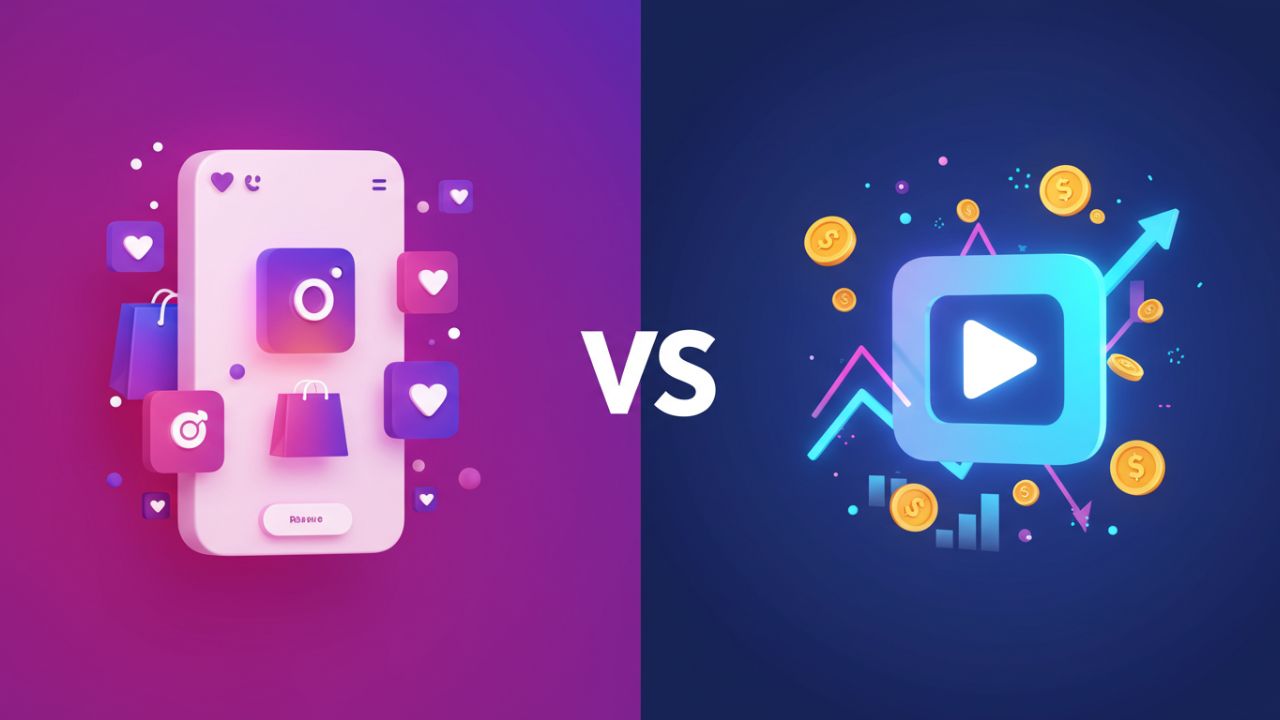In the ever-evolving world of digital marketing, businesses, content creators, and influencers are constantly faced with a critical decision: where should they invest their time, money, and efforts? Two of the most dominant platforms, Instagram and YouTube, stand out as the go-to choices for those looking to grow their brand, engage audiences, and monetize content. But which one is the better investment?
This article explores the pros and cons of Instagram and YouTube, comparing their reach, engagement, monetization opportunities, content formats, and future growth potential.
1. Audience Reach and Demographics
One of the first things to consider when choosing between Instagram and YouTube is the audience.
- Over 2 billion monthly active users.
- Majority of users are aged 18-34, making it ideal for targeting younger demographics.
- High engagement in industries like fashion, beauty, fitness, and lifestyle.
- More mobile-driven, with shorter content consumption habits.
YouTube
- Over 2.5 billion monthly active users.
- Wider demographic reach, including a significant presence of older age groups (35-65+).
- Preferred platform for educational content, tech reviews, gaming, and long-form storytelling.
- Desktop and mobile-friendly, allowing for longer content consumption.
2. Content Formats and Consumption Behavior
The way audiences consume content on each platform differs significantly.
- Focuses on short-form content: Reels (up to 90 seconds), Stories (15-second clips), and carousel posts.
- Highly visual and fast-paced, making it ideal for quick updates, trends, and brand visibility.
- Stories disappear after 24 hours unless saved as Highlights.
- Limited capacity for long-form storytelling.
YouTube
- Known for long-form content: videos can range from a few minutes to hours.
- Provides deeper engagement through detailed explanations, storytelling, and entertainment.
- Users actively search for videos, making it more evergreen compared to Instagram’s fast-paced algorithm.
- Offers YouTube Shorts (up to 60 seconds) as an alternative to Instagram Reels and TikTok.
3. Monetization Opportunities
If your goal is to generate revenue, YouTube is generally considered more profitable than Instagram. Here’s why:
Instagram Monetization
- Brand Sponsorships: The main way influencers make money is through brand deals, where they promote products in posts or Stories.
- Instagram Subscriptions: Allows creators to charge followers for exclusive content.
- Instagram Badges & Gifts: Viewers can send money during live streams and Reels.
- Affiliate Marketing: Earn commissions by promoting products.
- Instagram Shopping: Ideal for e-commerce brands selling directly on the platform.
YouTube Monetization
- YouTube Partner Program (YPP): Creators earn ad revenue from YouTube’s AdSense once they reach 1,000 subscribers and 4,000 watch hours.
- Super Chats & Stickers: Viewers can donate money during live streams.
- Memberships: Creators can charge a monthly fee for exclusive perks.
- Affiliate Marketing & Sponsorships: Similar to Instagram but with a higher chance of engagement due to longer watch times.
- Merchandise Shelf: Allows creators to sell products directly on their channel.
Winner: YouTube provides more stable and scalable monetization options compared to Instagram.
4. Algorithm and Engagement Rates
Instagram Algorithm
- Prioritizes engagement signals (likes, comments, shares, saves).
- Content lifespan is short-lived, meaning posts fade quickly unless they go viral.
- Highly competitive, requiring consistent posting to maintain visibility.
- Favorable to creators who jump on trends quickly.
YouTube Algorithm
- Search-based and recommendation-driven, meaning well-optimized videos can gain views months or even years after uploading.
- Encourages longer watch times, which leads to higher engagement and retention rates.
- Rewards creators who produce consistent, high-quality content rather than just frequent posts.
Winner: YouTube’s algorithm provides more longevity for content, making it a better platform for passive income and evergreen content.
5. Advertising and Paid Promotion
Both platforms offer advertising options, but they function differently.
Instagram Ads
- Focuses on in-feed ads, Stories ads, Reels ads, and carousel ads.
- Ideal for quick brand awareness and impulse purchases.
- Works well for e-commerce and DTC (direct-to-consumer) brands.
YouTube Ads
- Includes pre-roll, mid-roll, and banner ads.
- Best for long-term brand building.
- Stronger in industries like tech, education, finance, and entertainment.
6. Competition and Market Saturation
Instagram is extremely competitive, with millions of influencers and businesses vying for attention. The need for constant content creation can be exhausting.
YouTube, while competitive, has a better content discovery system, allowing creators to gain views over time rather than relying on immediate engagement.
Winner: YouTube provides better long-term content discoverability.
7. Future Growth and Trends
Instagram’s Future
- Continues to prioritize Reels to compete with TikTok.
- Expanding monetization tools, but still reliant on sponsorships.
- Algorithm changes make organic growth harder for new creators.
YouTube’s Future
- Growing dominance of Shorts indicates YouTube is embracing short-form content.
- AI-driven recommendations improving content discovery.
- Stable monetization makes it more appealing for full-time creators.
Conclusion: Which One is Better?
The best platform depends on your goals:
- Choose Instagram if you want quick engagement, brand deals, and visual storytelling.
- Choose YouTube if you want long-term discoverability, passive income, and in-depth content.
For most content creators and brands looking for sustainable revenue, YouTube is the better investment. However, integrating both platforms can maximize growth and reach.
Final Tip:
If possible, repurpose content between the two platforms. Use Instagram for quick audience engagement and YouTube for longer, valuable content that builds a loyal community.

Leave a Reply